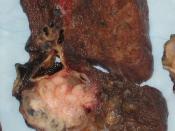Cancer, new growth of tissue resulting from a continuous growth of abnormal cells that have the ability to enter and destroy other tissues. Cancer, which may arise from any type of cell and in any type of body tissue, is not a single disease but a large number of diseases classified according to the tissue and type of cell of origin. Several hundred such classes exist, constituting three major subtypes: Sarcomas - from connective and supportive tissue, such as bone, cartilage, nerve, blood vessel, muscle, and fat.
Carcinomas, - include the most frequently occurring forms of human cancer, arise from soft tissues, such as the skin and the lining of the body cavities and organs, and the glandular tissue of the breast and prostate. Carcinomas, with a structure resembling skin, are termed squamous cell carcinomas. Those that resemble glandular tissue are called adenocarcinomas.
Leukemia's and lymphomas - cancers that involve blood-forming tissue and are typed by the enlargement of the lymph nodes, the invasion of the spleen and bone marrow, and the overproduction of immature white blood cells.
A cancerous growth, or neoplasm, is clonal - that is, all it's cells are descendants of a single cell. These cells have escaped the control of the normal forces regulating cellular growth by using an enzyme called telomerase, which allows the malignant cells to reproduce endlessly and at a rapid pace. Resembling embryonic cells, they are unable to differentiate or mature into an adult, functioning state. As these cells multiply, they may form a mass called a tumor, which enlarges and continues to grow without regard to the function of the tissue of its origin.
Almost all cancers form tumors, but not all tumors are cancerous, or malignant; the greatest number are benign. Benign tumors are characterized by localized growth and are...


